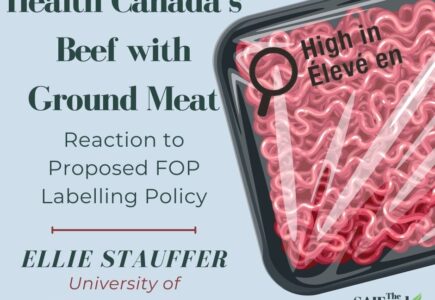By Ellie Stauffer
University of Saskatchewan student
When I was in high school, a classmate of mine announced to the class that he believed the beef was unhealthy and bad for the environment, and that the entire industry should be abolished. Naturally, as someone who had grown up on a cow-calf operation, I was very shocked to hear this sentiment. I had grown up believing everyone else had the same understanding of agriculture that I did, but this was the moment I discovered that the relationship between the beef industry and the public was more complicated than I had previously thought.
Most consumers are at least three generations removed from the farm. This leaves room for a lot of disconnect between actual farming practices and public perception of those practices. As a result, issues like animal welfare, nutrition, and climate change have become associated with the beef industry. For example, there has been a rising fear of practices such as the use of antibiotics and hormones in beef cattle. However, there is ample research guaranteeing the safety of beef consumption with the use of antibiotics and hormones as their uses are heavily regulated. Many consumers are not familiar with how beef production looks and farmers and ranchers are not exactly rushing to show them. This is not necessarily the fault of the consumer or producer, but it has resulted in a more complicated relationship. Unfortunately, the disconnect is not only seen at a grocery store level, but now also at government level, which was demonstrated clearly in 2022.
Ground Beef Under Debate
In June 2022, Health Canada proposed front-of-package (FOP) nutrition labels on food items with high levels of sodium, sugar, or saturated fat. The idea behind these labels was to draw consumers’ attention to the levels of one of these three ingredients to enable more informed and health-conscious decision making. Pre-packaged and general packaged foods were the main target of this labelling, but there was one food item on the original list that left Canadian ranchers scratching their heads – ground beef. All other cuts of beef and meats in general (fish, chicken, pork, etc.) were exempt from the labelling as they are recognized as single-ingredient food products with health benefits, regardless of if they met the labelling criteria. Dairy products, such as cheese, were also exempt from labelling even though some products contain over the recommended daily intake of sodium and or saturated fats. Ground beef, despite being a single-ingredient food product itself, was left on the list for being “high in saturated fats.” This was a confusing inclusion for this labelling policy as saturated fat content is more of a question of the leanness or marbling quality of the cut itself, so ground beef is not necessarily higher in saturated fats than other cuts of beef.
So why was ground beef targeted, in particular? This is what the beef industry and stakeholders asked in uproar upon the introduction of this policy. The Canadian Cattle Association voiced their opposition to the policy, calling that all cuts of beef should be exempt from labelling. On the other end, there were groups that applauded Health Canada’s proposal, calling it “climate-focused” as it aligned with their push for plant-based protein alternatives. Nonetheless, Health Canada amended the policy to exempt ground beef from the labelling shortly after the proposal. The reason behind this change was that “[requiring] a symbol on ground meats and poultry and not on whole cuts of meat may lead people in Canada to erroneously believe that all whole cuts are healthier than ground.”
What Can Policy Makers Do With This Information?
If this policy was amended so quickly, why should we care? Because this situation speaks to a larger issue seen within the agriculture industry in general. With the relationship between politicians, policy makers, and producers already complicated by misinformation and lack of communication, a policy singling out ground beef could be very damaging to public perception of eating beef and of agriculture in general.
Research shows that beef is a nutrient dense, whole, single-ingredient food product with many health benefits including maintaining muscle mass and improved brain function when eaten in appropriate proportions. Adding warning labels on ground beef is not a fully science-based decision, which gives the impression that it was instead partially based on societal trends. A survey in 2021 from Food in Canada shows that 44% of Canadians believe reducing beef consumption is beneficial, with the main reason being for health-related reasons. This perception of eating beef is clearly very common amongst Canadians, despite the evidence that disproves these beliefs. For politicians and policy makers, these misinformed trends could be viewed as opportunities to capitalize on for the sake of popularity – which is perhaps what we saw with this instance of FOP labelling and Health Canada. While it may be beneficial for politicians, misinformed policy is not beneficial for the health of Canadians.
Fortunately, the solution is simple. Thorough consultations between the government and the relevant agriculture sectors can assure that food policy is well-informed and factual. This relationship is essential to creating evidence-based policy for the benefit of Canadians. The goals of beef stakeholders and Health Canada align more than it would seem. Both seek to provide Canadians with the information and food products needed to form a nutritious, balanced diet and this can be achieved with effective collaboration.
Biography

My name is Ellie Stauffer and I am pursuing a Bachelor of Science in Agribusiness at the University of Saskatchewan, expecting to convocate in June 2024. I am originally from Pincher Creek, Alberta, where my family and I run a purebred, black angus cattle operation. Growing up on the farm, participating in agricultural programs like 4-H, and getting my post-secondary education in agriculture has developed my passion for the industry into what it is now. Canadian agriculture is innovative and resilient, and I couldn’t be more proud to be a part of it.


